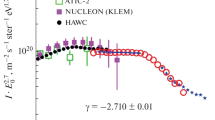Summary
The production of penetrating secondaries by cosmic rays at 50 m w.e. has been investigated by means of a counter hodoscope. The cross section (in lead) for events which can be interpreted as pairs of associated penetrating particles (a.p.p.) is not larger than (13±3)·10−30 cm2/nucleon. Such a value is deduced from measurements of the corresponding differential cross section as a function of the penetration of the secondary particles produced (section 4·3 table V). A value of the same order of magnitude is found for the production ofa.p.p. in rock (section 4·5). Furthermore it is shown that the events that can be interpreted as showers penetrating 15 cm Pb, have a frequency that can be explained, at least in part, as due to purely electromagnetic interaction. Therefore one can establish an upper limit of a few units in 10−30 cm2/nucleon for the cross section for production in Pb of penetrating showers by μ-mesons. Finally we discuss those events which appear to be due to a few penetrating particles coming from the rock and it is shown that they can be accounted for, by considering besides the production of penetrating showers in rock the penetrating particles present in the vicinity of the core of extensive air showers.
Riassunto
A mezzo di un sistema di contatori collegati ad un odoscopio, viene studiata la produzione di secondari penetranti, in piombo e in roccia, da parte della radiazione cosmica a 50 m di acqua equivalente. Per gli eventi interpretabili come coppie di particelle penetranti associate, si deduce una sezione d'urto totale in Pb non superiore a (13±3)·10−30 cm2/nucleone: questo valore è dedotto da misure di sezione d'urto differenziale rispetto al percorso dei secondari prodotti (paragrafo 4·3, tabella V). Un valore dello stesso ordine di grandezza viene dedotto per la produzione in roccia. Si mostra inoltre che gli eventi interpretabili come sciami capaci di penetrare 15 cm di Pb hanno una frequenza tale da poter essere spiegati, almeno in parte, come dovuti ad interazioni puramente elettromagnetiche. Si stabilisce pertanto un limite superiore della sezione d'urto in Pb per la produzione di sciami penetranti da parte di mesoni μ di qualche unità in 10−30 cm2/nucleone (paragrafo 4·4). Infine si discutono quegli eventi che si presentano come dovuti a più particelle penetranti provenienti dalla roccia e si mostra come questi possano essere dovuti oltre che a sciami penetranti prodotti in roccia anche alle particelle penetranti presenti nelle vicinanze dell'asse di uno sciame esteso atmosferico.
Similar content being viewed by others
Literatur
E. P. George andJ. Evans:Proc. Phys. Soc.,63, 1248 (1950);64, 195 (1951).
G. Cocconi andV. Cocconi-Tongiorgi:Phys. Rev.,84, 29 (1951);M. F. Crouch andR. Sard:Phys. Rev.,85, 120 (1952);R. D. Sard, M. F. Crouch, D. R. Jones, A. M. Conforto andB. F. Stearns:Nuovo Cimento,8, 326 (1951). We thank doctorSard for having communicated his results before publications.
E. P. George andP. Trent:Nature,164, 839 and 248 (1949).
H. J. Braddick andG. S. Hensby:Nature,44, 1012 (1939);H. J. Braddick, W. F. Nash andA. W. Wolfendale:Phil. Mag.,42, 1277 (1951).
S. Hayakawa:Phys. Rev.,84, 37 (1951).
M. Conversi, E. Pancini andO. Piccioni:Phys. Rev.,68, 232 (1945) and71, 209 (1947);E. Fermi andE. Teller:Phys. Rev.,72, 399 (1947);E. Fermi, E. Teller andV. Weisskopf:Phys. Rev.,71, 314 (1947).
E. Amaldi andG. Fidecaro:Nuovo Cimento,7, 535 (1950);Phys. Rev.,81, 339 (1951).
F. Nash: Ph. D. Thesis, Manchester; reported inJ. G. Wilson:Progress in Cosmic Rays Physics (Amsterdam, 1952).
E. Amaldi, C. Castagnoli, S. Sciuti andA. Gigli:Proc. Phys. Soc.,65, 556 (1952).
S. Hayakawa:Proc. Phys. Soc.,65, 215 (1952).
E. Amaldi, C. Castagnoli, A. Gigli andS. Sciuti:Nuovo Cimento,9, 453 (1952).
M. Mandò:Nuovo Cimento,9, 517 (1952).
R. R. Wilson:Phys. Rev.,86, 261 (1952).
B. Gregory andJ. H. Tinlot:Phys. Rev.,81, 667 (1951).
G. Cocconi, V. Cocconi-Tongiorgi andK. Greisen:Phys. Rev.,76, 1020 (1949).
G. Cocconi:Progress Report n. 1 of Cornell University (September 1951).
B. Rossi andK. Greisen:Rev. Mod. Phys.,13, 240 (1941).
K. Greisen:Phys. Rev.,75, 1071 (1949).
W. Heisenberg:Kosmische Strahlung (Berlin, 1943), cap. 2.
H. J. Bhabha andK. Chakrabarty,Phys Rev.,74, 1352 (1948).
Author information
Authors and Affiliations
Additional information
Dell'Istituto di Fisica dell'Università di Pavia, attualmente in congedo presso l'Istituto Nazionale di Fisica Nucleare, Sezione di Roma.
Rights and permissions
About this article
Cite this article
Amaldi, E., Castagnoli, C., Gigli, A. et al. On the interaction of cosmic rays with matter under 50 metres water equivalent. Nuovo Cim 9, 969–1003 (1952). https://doi.org/10.1007/BF02786163
Received:
Published:
Issue Date:
DOI: https://doi.org/10.1007/BF02786163




